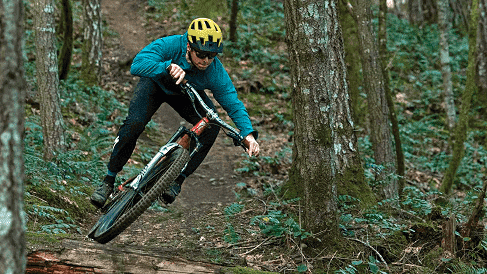Are you looking for the best carbon handlebar mtb? The handlebar is one of just two control-related contact points on your mountain bike. Simple updates can help you enhance handling, performance, comfort, and weight savings when out on the trail. Handlebars are available in a variety of materials, widths, geometries, and clamp diameters, as well as stiffness, compliance, and vibration absorption levels.
- Part 1: Why Use Carbon Handlebars Mtb
- Part 2: Evaluation of Carbon Handlebars
- Part 3: The First Impression of Carbon Handlebars
- Part 4: Tutorial of Carbon Handlebars
- Part 5: Features of Carbon Handlebars
- Part 6: Overview of Carbon Handlebars
- Part 7: Advantages of Carbon Handlebars
- Part 8: Disadvantages of Carbon Handlebars
Part 1: Why Use Carbon Handlebars Mtb
Carbon Mtb handlebars may be the answer if you want to improve the performance and comfort of your mountain bike. They’re lighter than aluminum bars, which means they’ll make those lengthy climbs a little easier.
They also provide additional control while riding due to their rigidity. Carbon bars also reduce trail vibration, allowing you to enjoy a smoother ride with less discomfort in your hands and wrists.
Carbon handlebars Mtb have a reputation for being dangerous. The concern stems from reports of how brittle carbon fiber handlebars may be and how easily they can be damaged.
I’m not going to lie to you: carbon bars can fail without you even recognizing them under certain conditions. However, you’re unlikely to notice the conditions that cause a carbon handlebar to snap.
However, you must consider the following two factors:
- On impact, carbon fiber is far more rigid than steel or aluminum.
- Handlebars Mtb carbon may have minor flaws that are not noticeable to the human eye and will only become apparent after a hard landing.
Aside from those two concerns, carbon fiber handlebars have no other significant drawbacks. As I have stated, the risk is not the same as some would have you believe.
A carbon handlebar will be more resistant to fatigue (due to normal use) and can survive even longer than an aluminum handlebar in the absence of a catastrophic incident.
Mountain bikes with carbon fiber handlebars are more pleasant to ride. This is because, unlike steel or aluminum bars, they absorb some of the trail’s vibrations rather than transferring them back to your hands and wrists. As a result, a carbon handlebar can aid in arm fatigue reduction during lengthy rides.
Part 2: Evaluation of Carbon Handlebars
Mountain Bike Made of Carbon A mountain bike’s handlebars are one of the most expensive components. A nice set will easily cost you over $100, and some high-end models will cost even more. So there’s no going back if you make a mistake when it comes to upgrading your mountain bike handlebar to carbon!
Carbon mountain bike handlebars, like practically every upgrade, have one main drawback: they’re more expensive.
Carbon mtb handlebars have a more complicated manufacturing process than aluminum alloys, which raises the price. “Well, how much?” becomes the magic question, as it always is.
Carbon handlebars are more expensive than aluminum alloy handlebars, even without doing any calculations.
An $89 raise isn’t awful when compared to the whole cost of a mountain bike, which quickly climbs into the thousands of dollars. Aluminum handlebars, on the other hand, are unquestionably the most cost-effective of the possibilities.
Part 3: First Impression of Carbon handlebars
The handlebar is available in three styles: Base (aluminum), Plus (aluminum), and Race (aluminum) (carbon). Each handlebar has the same 9° backsweep and 5° upsweep, which they believe makes it easier on the wrists on long, steep downhills. The only width available is 800mm, which, in my opinion, is the only width that should be available because bars may be adjusted shorter but never longer.
The ends of the bars have printed lines on them to make cutting them down a breeze. It comes in two different rises: 20mm and 35mm. To produce a better, more pleasant ride feel, e*thirteen spent time creating layups, butting, and bend profiles.
“Am I going to notice a difference between this and what I already have?” I questioned as I slid into the Mtb carbon handlebar. Yes, to put it succinctly. I had a carbon handlebar mtb before putting the e*thirteen things on. This isn’t the most costly or over-engineered cockpit ever, but it’s still quite good. Ultimately, it comes down to how the ride feels and whether or not their focus on rider comfort paid off.
The setup was simple enough. I had my concerns after the parking lot test revealed a stiff-feeling bar. So I wasn’t expecting it to be that much more comfortable than what I’m used to. Created something that is satisfying to hold on to.
The route I chose for my first ride is rocky, and the carbon mtb handlebar played great. While it may not have smoothed out the track (would you expect it to? ), it did make for a more comfortable ride than I’m used to.
Vibrations were a little less severe, and hard impacts were a little softer. Overall, the Mtb carbon handlebar put together a fantastic first step into the world of mountain bike cockpits.
Part 4: Tutorial of Carbon Handlebars
A good grip on your handlebar and quick access to your brakes and shifter can improve your ride by enhancing comfort and control when blasting over rocky singletrack or plunging into steep mountain bike descents.
However, choosing the correct handlebar for your riding style and setting up your cockpit for maximum performance is not as straightforward as it may appear.
Handlebar Mtb carbon Setup Guide will help you choose the perfect bar shape and width for your bike. As well as tune your brake levers, shifter, and dropper lever so you can ride quicker and feel more confident on the trails.
The Right Tools
Installing your handlebar Mtb carbon to cm and configuring your controls is an important part of establishing a strong bond between you and your mountain bike. The appropriate setup will help you gain control on the trails, which will boost your confidence and skill.
However, before you begin making any adjustments, double-check that you have the right tools for the job. Allen key wrenches and, in rare situations, a T25 Torx key are used on most bikes and cockpit components.
Installing Your Handlebar
It’s time to get the installation procedure started. Make sure your handlebar is centered in your stem to begin. To help with this, most bars include easy-to-see markings. Line up the markings on both sides of the stem and make sure they’re equal.
After that, rotate your handlebar to get the most out of it.
When looking down at your bars, rotate the bars for the maximum rise to view the back sweep. Simply avoid rolling the bar too far forward, since this will cause the backsweep to become upsweep and “straighten” the bar’s ends.
Rolling the bar too far backward, on the other hand, has the effect of “flattening” the ends and pushing the bar too far backward.
Part 5: Features of Carbon Handlebars
Damping Performance – So, what are the features of Mtb carbon handlebars? For starters, carbon bars can reduce vibrations better than most alloy bars without being heavy and bulky. So, what does that imply when you’re out on the trail?
Carbon can absorb vibrations differently than alloy when riding through difficult chattery portions of the trail. Carbon handlebars can help absorb and dampen chatter so you don’t feel every vibration. When you’re out on a long ride, this might make all the difference in terms of hand comfort.
Flex Pattern – Another feature of hand bar carbon mtb is that it allows you to carefully position each piece of carbon into the mold when using vertical carbon. This allows you to control the flex pattern effectively without losing overall strength.
Naturally, there is a science to this procedure, and each manufacturer has its unique method. This is similar to butted aluminum in that the wall thickness of the material can be changed along the length of the aluminum tube but on a different level.
At the end of the day, manufacturers can fine-tune the flex and compliance characteristics of handlebars far more successfully using carbon handlebars.
Lightweight – One of the most positive features of carbon handlebars is their minimal weight. Carbon handlebars may be just as strong as metal handlebars while only a fraction of the weight. Carbon bars may be a wonderful alternative if you are concerned about your weight.
Cost – One of the features of carbon handlebars is that they are just more expensive than aluminum handlebars, often twice as much. Carbon rims, like carbon and aluminum rims, are more expensive to produce.
Part 6: Overview of Carbon Handlebars
Handlebars. They’re more than just a bent tube, though. They’re vital not only for physically hanging on to your bike, but also for how it feels on the trail and, more significantly, how well it fits you.
Width
For several years, the width of a handlebar has been one of the most popular topics in mountain riding. Anything longer than 700mm (27.5in) was once looked upon, but today some UCI World Cup DH racers have broken the 800mm (31.5in) barrier.
Height
Taller bars help to carry your weight backward on bikes with low front ends or when tackling steep terrain, whilst lower rise bars function well on faster, flatter trails or bikes with high stack heights. Typically, bars come in rises ranging from absolutely flat (though this is becoming less common) to 40mm.
Diameter
The move to a thicker 35mm clamping surface is the latest trend in handlebars. Manufacturers are moving in that direction, and as a result, aftermarket companies are following suit. This is an increase from the previous standard of 31.8mm. Remember that thicker bars necessitate a larger stem to match.
Part 7: Advantages of Carbon Mtb Handlebar
Improved Vibration Absorption
Your hands are the only part of your body that is always connected to the bike, except your feet. Your hands and arms can practically take a beating from the handlebars on extended rides on tough terrain.
Carbon handlebars have enhanced vibration dampening properties, which is one of the most unappreciated features.
Shock waves from hitting bumps on the path are transmitted directly into your hands and arms when you ride with aluminum handlebars.
Rather than sending all of that energy directly to you, carbon handlebars assist by absorbing and dispersing some of it. Vibration damping is the term for this property.
While this may not appear to be a significant issue, consider how your arms feel after a long or difficult ride. Isn’t it a little battered at times? Carbon fiber, on the other hand, absorbs a lot of energy, preventing hand fatigue and the dreaded arm pump.
The added comfort will enhance your entire mountain biking experience, regardless of the length or difficulty of the ride.
Carbon Handlebars are Warmer in Cold Weather
In cold weather, one benefit of carbon handlebars that I rarely hear mentioned is that they keep your hands warmer. Carbon fiber handlebars outperform aluminum and any other metal pair of handlebars in terms of warmth due to their low thermal conductivity.
The ability of a material to draw heat in is referred to as thermal conductivity. On a mountain bike, your body is the only source of heat. Thus heat is drawn away from your hands and into the handlebars. As heat escapes from your hands, they get cold, making steering and riding more difficult.
I don’t know about you, but riding a mountain bike with cold or numb hands has to be one of the most inconvenient experiences. Sure, you could try wearing thicker gloves, but it won’t help you manage!
Increased Stiffness
While some flex may appear to be beneficial in absorbing trail pressures. It is far from reassuring when cornering or steering through difficult terrain.
Carbon handlebars are stronger than aluminum-alloy equivalents and can provide a better steering feel when navigating these sections.
While carbon is a stiffer material, the diameter of the handlebars at the clamp also has a significant impact on the stiffness of the handlebar.

Part 8: Disadvantages of Carbon Handlebar Mtb
Increased Cost
Carbon mountain bike handlebars, like practically every upgrade, have one main drawback: they’re more expensive.
Carbon handlebars have a more complicated manufacturing process than aluminum alloys, which raises the price. “Well, how much?” becomes the magic question, as it always is.
Carbon handlebars are more expensive than aluminum alloy handlebars, even without doing any calculations.
The average price of aluminum handlebars in this data set was $68.99, whereas the average price of carbon handlebars was $157.99. That’s a little more than twice the expense of upgrading to carbon handlebars.
An $89 raise isn’t awful when compared to the whole cost of a mountain bike, which quickly climbs into the thousands of dollars. Aluminum handlebars, on the other hand, are unquestionably the most cost-effective of the possibilities.
Damage is Hard to Detect
Metal is a flexible substance in general. It can flex before breaking, in other words. If your handlebars are bent or distorted after a crash, it’s very evident that they’ve been damaged. This makes determining whether it’s time to replace them before they entirely fail and shatter a lot easier.
Carbon’s great rigidity, on the other hand, implies that instead of bending during failure, it simply breaks. Hairline cracks can appear, but they’re difficult to spot. If you continue to ride on a pair with damaged handlebars without realizing it, they could break at any time.
Installation Requires a Special Tool
Carbon handlebars Mtb, unlike aluminum alloy handlebars, which can be locked into the stem with any tool, require the use of a torque wrench for effective installation. Overtightening the handlebars might result in stress cracks and fractured bars due to their fragile nature.
You’ll need to use a torque wrench to tighten the handlebars down to the manufacturer’s torque specifications. This is commonly written as “4 Nm,” which stands for “four Newton-metres of torque applied.”
Carbon handlebars are, in my opinion, one of the best changes you can do to your mountain bike. For me, the vibration dampening alone makes them useful because it helps me to enjoy my time on the trail while also reducing fatigue.
When you consider the increased stiffness and improved cold performance, it’s a no-brainer for me.
While there are a few drawbacks, the one that will most certainly cause concern is the price. This, however, appears to be a non-factor to me when compared to the entire cost of the bike and other prospective improvements.
Of course, your unique circumstances may differ significantly, thus it is ultimately a personal decision for you to make.









